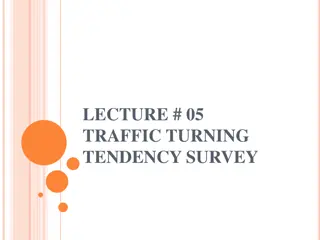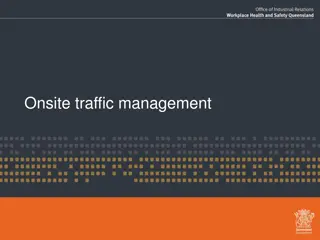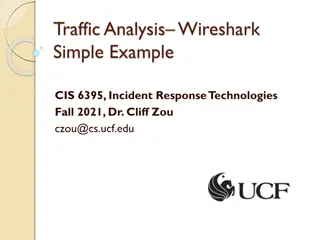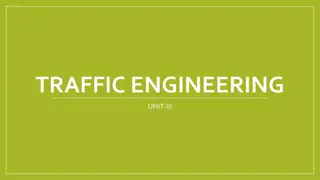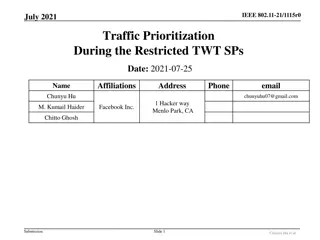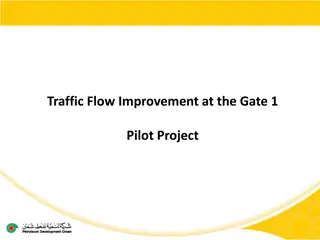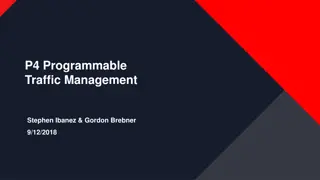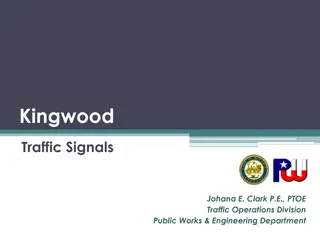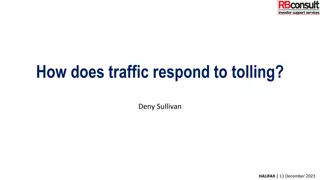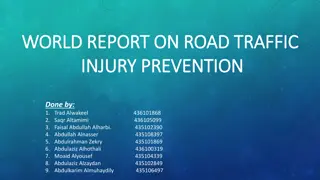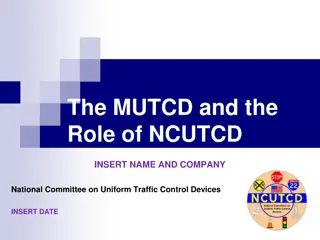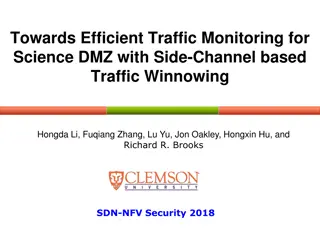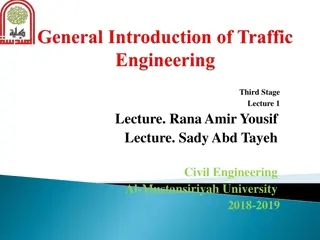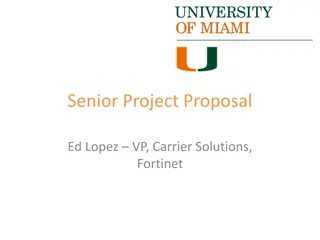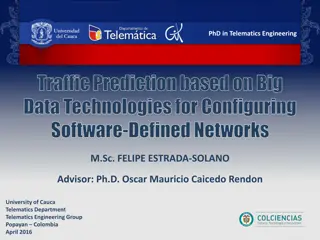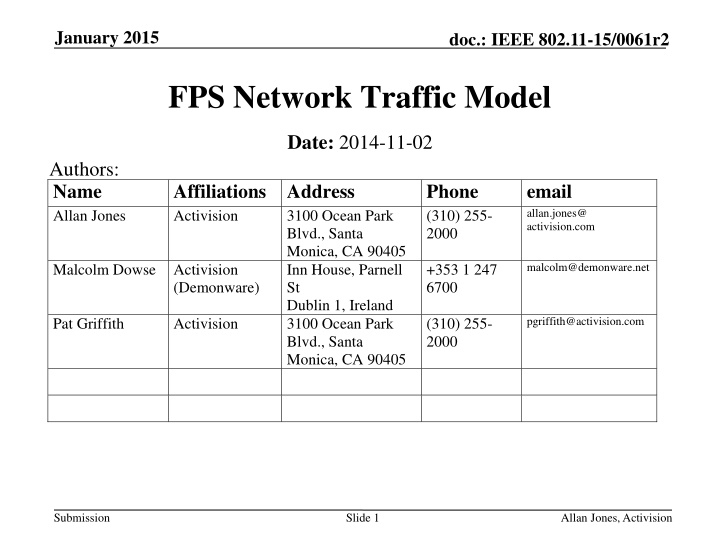
Network Traffic Models in FPS Games
Dive into the intricate world of network traffic in multiplayer First Person Shooter (FPS) online games. Explore the unique challenges, characteristics, and architectures that shape the network traffic landscape in FPS gaming, providing insights for simulation scenarios and server models.
Download Presentation

Please find below an Image/Link to download the presentation.
The content on the website is provided AS IS for your information and personal use only. It may not be sold, licensed, or shared on other websites without obtaining consent from the author. If you encounter any issues during the download, it is possible that the publisher has removed the file from their server.
You are allowed to download the files provided on this website for personal or commercial use, subject to the condition that they are used lawfully. All files are the property of their respective owners.
The content on the website is provided AS IS for your information and personal use only. It may not be sold, licensed, or shared on other websites without obtaining consent from the author.
E N D
Presentation Transcript
January 2015 doc.: IEEE 802.11-15/0061r2 FPS Network Traffic Model Date: 2014-11-02 Authors: Name Allan Jones Affiliations Address Activision Phone (310) 255- 2000 email allan.jones@ activision.com 3100 Ocean Park Blvd., Santa Monica, CA 90405 Inn House, Parnell St Dublin 1, Ireland 3100 Ocean Park Blvd., Santa Monica, CA 90405 malcolm@demonware.net Malcolm Dowse Activision +353 1 247 6700 (Demonware) pgriffith@activision.com Pat Griffith Activision (310) 255- 2000 Submission Slide 1 Allan Jones, Activision
January 2015 doc.: IEEE 802.11-15/0061r2 Abstract The purpose of this presentation is to provide network traffic details of multiplayer First Person Shooter (FPS) online games. Modern popular FPS games present unique challenges when it comes to network traffic. From this profile we can cooperatively develop a simulation that can be incorporated into simulation scenarios. Submission Slide 2 Allan Jones, Activision
January 2015 doc.: IEEE 802.11-15/0061r2 FPS Network Traffic Model Characteristics of most FPS games Low bit-rate Sensitive to the impacts of delay(latency) and Jitter [3] [6] [7] High frequency of small packets (UDP) Short Duration (matches lasting around 10 min.) Client-Server Architecture (Dedicated/Local servers) Sensitive to QoS requirements[3][5] Submission Slide 3 Allan Jones, Activision
January 2015 doc.: IEEE 802.11-15/0061r2 FPS Network Traffic Model Architecture Dedicated Server The dedicated server model provides geographically dispersed servers to host the game matches with optimal network paths. Some implementations[1] use virtual servers to provide the necessary matchmaking and virtual world state services while others use a combination of physical dedicated servers and console servers. Submission Slide 4 Allan Jones, Activision
January 2015 doc.: IEEE 802.11-15/0061r2 FPS Network Traffic Model Typical modern console game 18 player match (Dedicated Server) Submission Slide 5 Allan Jones, Activision
January 2015 doc.: IEEE 802.11-15/0061r2 FPS Network Traffic Model Architecture Console (Local) Server The console server model elects one of the consoles to host the game and synchronize the other consoles throughout the match. This console also plays the game as well. Statistics are still managed by centralized servers, but the majority of the network traffic is handled by the consoles. This model has key economic advantages as there does not need to be as many dedicated servers in order to host all the games and utilizes the consoles network bandwidth which lowers bandwidth costs as well. Submission Slide 6 Allan Jones, Activision
January 2015 doc.: IEEE 802.11-15/0061r2 FPS Network Traffic Model Typical modern console game 18 player match (Console Server) Submission Slide 7 Allan Jones, Activision
January 2015 doc.: IEEE 802.11-15/0061r2 FPS Network Traffic Model Client / Server Communications The client to server communications averages will vary for any specific FPS game as will the server to client communication. FPS games all have delay sensitivity (latency and jitter) that creates severe consequences to the quality of gameplay. (e.g. the player can lose the game due to delays in communications). Network requirements for FPS games will increase by the time 802.11ax is deployed. Earlier IEEE and other supporting studies show a 50ms round trip tolerance. (e.g. 50ms bursts from the server) [2][4] We can anticipate the 50ms threshold to be around 25-30ms as 802.11ax is released. Submission Slide 8 Allan Jones, Activision
January 2015 doc.: IEEE 802.11-15/0061r2 FPS Client Packets/sec 250 200 P a c k e t s 150 FPS 1 FPS 2 100 FPS 3 50 0 11 21 31 41 51 61 71 81 91 1 101 111 121 131 141 151 161 171 181 191 201 211 221 Seconds 231 241 251 261 271 281 291 301 311 321 331 341 351 361 371 381 391 401 411 421 431 441 451 Submission Slide 9 John Doe, Some Company
January 2015 doc.: IEEE 802.11-15/0061r2 FPS Client Bits/Sec 450000 400000 350000 300000 B i t s 250000 FPS 1 200000 FPS 2 FPS 3 150000 100000 50000 0 11 21 31 41 51 61 71 81 91 1 101 111 121 131 141 151 161 171 181 191 201 211 221 Seconds 231 241 251 261 271 281 291 301 311 321 331 341 351 361 371 381 391 401 411 421 431 441 451 Submission Slide 10 John Doe, Some Company
January 2015 doc.: IEEE 802.11-15/0061r2 FPS Server Packets/sec 900 800 700 600 P a c k e t s 500 FPS 1 400 FPS 2 FPS 3 300 200 100 0 11 21 31 41 51 61 71 81 91 1 101 111 121 131 141 151 161 171 181 191 201 211 221 Seconds 231 241 251 261 271 281 291 301 311 321 331 341 351 361 371 381 391 401 411 421 431 441 451 Submission Slide 11 John Doe, Some Company
January 2015 doc.: IEEE 802.11-15/0061r2 FPS Server bits/sec. 6000000 5000000 4000000 B i t s 3000000 FPS 1 FPS 2 FPS 3 2000000 1000000 0 11 21 31 41 51 61 71 81 91 1 101 111 121 131 141 151 161 171 181 191 201 211 Seconds 221 231 241 251 261 271 281 291 301 311 321 331 341 351 361 371 381 391 401 411 421 431 441 Submission Slide 12 John Doe, Some Company
January 2015 doc.: IEEE 802.11-15/0061r2 FPS Network Traffic Model Client/Server Packet and bandwidth profile The client to server communications and server to client averages are presented in the table below. Description FPS 1 FPS 2 FPS 3 Average Client Packets/sec server 29 34 41 Average Client bits/sec server 37018 23118 54039 Average Server Packets/sec client 10 26 77 Average Server bits/sec client 20489 51464 269326 Average Server Aggregate Packets/sec clients 177 248 861 Average Server Aggregate bits/sec clients 372519 625974 2396306 Submission Slide 13 Allan Jones, Activision
January 2015 doc.: IEEE 802.11-15/0061r2 Comparison of FPS Client Packet Sizes 18000 16000 14000 12000 N u m b e r 10000 8000 FPS 1 FPS 2 6000 FPS 3 4000 2000 0 Packet Size Submission Slide 14 Allan Jones, Activision
January 2015 doc.: IEEE 802.11-15/0061r2 Comparison of FPS Server Packet Sizes 7000 6000 5000 4000 3000 FPS 1 FPS 2 FPS 3 2000 1000 0 Submission Slide 15 Allan Jones, Activision
January 2015 doc.: IEEE 802.11-15/0061r2 FPS Network Traffic Model Recommendation: The recommendation is to use the most network intense model (FPS3) that will ensure that our emerging standard can facilitate the needs of FPS games of today and emerging FPS multiplayer games over the next few years. Additionally since FPS games are extremely sensitive to network latency and jitter we need to ensure that our emerging standard adds as little latency as possible. Description FPS 1 FPS 2 FPS 3 Average Client Packets/sec server 29 34 41 Average Client bits/sec server 37018 23118 54039 Average Server Packets/sec client 10 26 77 Average Server bits/sec client 20489 51464 269326 Average Server Aggregate Packets/sec clients 177 248 861 Average Server Aggregate bits/sec clients 372519 625974 2396306 Submission Slide 16 Allan Jones, Activision
January 2015 doc.: IEEE 802.11-15/0061r2 References [1] Saroj Kar, Windows Azure: The power behind upcoming game Titanfall for the Xbox One , Silicon Angle February 25th, 2014 ; http://siliconangle.com/blog/2014/02/25/windows-azure-the-power- behind-blockbuster-game-titanfall-for-the-xbox-one/ [2] Mark Claypool, David LaPoint, and Josh Winslow. Network Analysis of Counter-strike and Starcraft ,InProceedings of the 22nd IEEE International Performance, Computing, and Communications Conference (IPCCC), Phoenix, Arizona, USA, April 2003 [3] Amit Sinha, Kenneth Mitchell, Deep Medhi Network Game Traffic: A Broadband Access Perspective , Computer Networks, vol. 49, no. 1, pp. 71-83, 2005 [4] L. Pantel, L. Wolf, On the impact of delay on real-time multiplayer games , Proc. International Workshop on Network and Operating System Support for Digital Audio and Video (NOSSDAV) (2002) 23-29 [5] Tristan Henderson, Saleem Bhatti Networked games A QoS sensitive application for QoS insensitive users? , ACM SIGCOMM 2003 Workshops August 25 & 27, 2003, Karlsruhe, Germany [6] Rahul Amin, France Jackson, Juan Gilbert, Jim Martin Assessing the Impact of Latency and Jitter on the Perceived Quality of Call of Duty Modern Warfare 2 , In HCI'13 Proceedings of the 15th international conference on Human-Computer Interaction: users and contexts of use - Volume Part III Pages 97-106, (2013) [7] Kjetil Raaen, Latency Thresholds for Usability in Games , NIK-2014 conference (2014) [8] Mark Claypool, Kajal Claypool, Latency Can Kill: Precision and Deadline in Online Games , February 22 23, 2010, Phoenix, Arizona, USA. Submission Slide 17 Allan Jones, Activision

